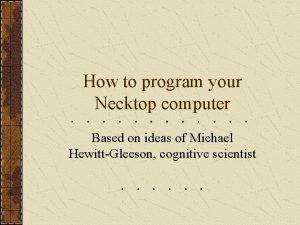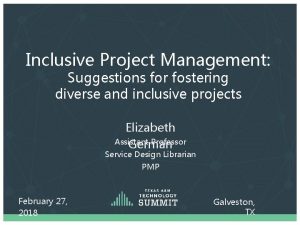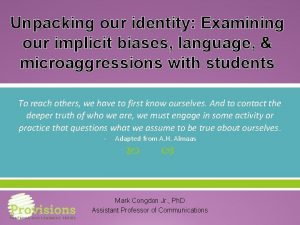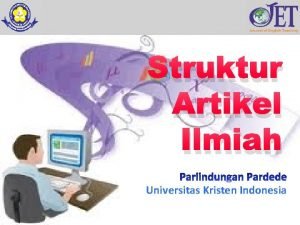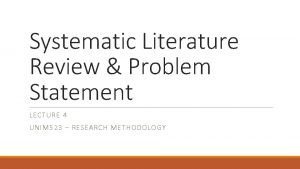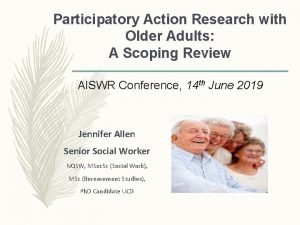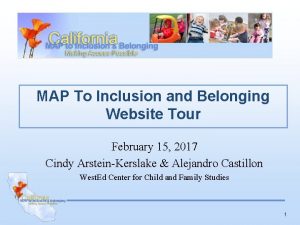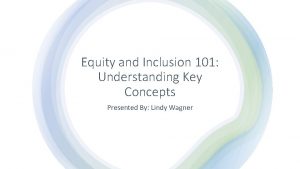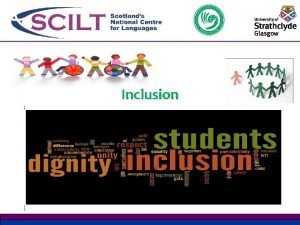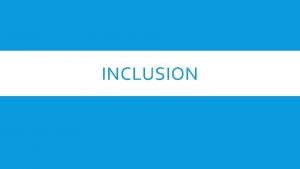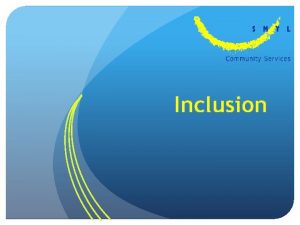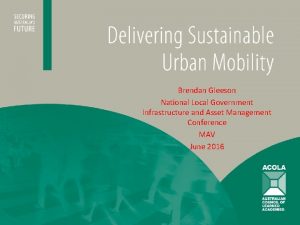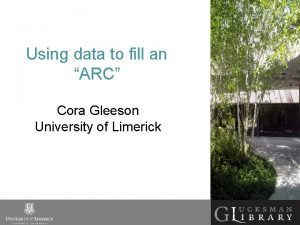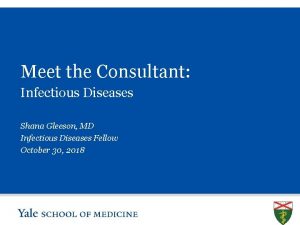The Access and Inclusion Model AIM Paul Gleeson










- Slides: 10

The Access and Inclusion Model (AIM) Paul Gleeson Department of Children and Youth Affairs (DCYA) Ireland System-wide approaches to embedding inclusive education Feb 19 th 2020, 13: 40

AIM, A model to support Access to ECCE Programme for children with disabilities. Overview • State funded Early Childhood Care and Education Programme (ECCE) was launched in 2010 • Inter Departmental Group set up to devise a model that would support access to the ECCE programme for children with disabilities. • The Access and Inclusion Model (AIM) , ensured that children with additional needs can access and meaningfully participate in ECCE in mainstream pre-school settings. • Endorsed by Government and implemented from September 2016 onward. AIM

AIM, A model to support Access to ECCE Programme for children with disabilities. The Model. Objective • To help providers to deliver an inclusive pre-school experience, ensuring that children with a disability can fully participate in the Early Childhood Care and Education (ECCE) programme. • The model progresses from a number of universal supports for all children with a disability to more targeted supports for children with complex needs arising from a disability.

AIM, A model to support Access to ECCE Programme for children with disabilities. Universal Supports • L 1 - An Inclusive Culture – Inclusion Coordinators in each setting, National Inclusion charter – Formal Training LINC • L 2 - Information for Parent and Providers – Dedicated AIM Website Information through local County Childcare Committee • L 3 - Qualified and Confident Workforce – CPD training – Hanen, Lámh & SPEL • L 4 - Expert Advice and Supports – Early Years Education Specialist providing expert support to practitioners and parents.

AIM, A model to support Access to ECCE Programme for children with disabilities. Targetted Supports. • L 5 - Equipment – A grant for minor works and specialised equipment to ensure children with disabilities to participate in the ECCE programme • L 6 - Therapeutic Intervention – Providing access to therapeutic services where the need is critical for child's participation in the ECCE programme • L 7 – Additional Assistance – Where Levels 1 through 6 are not enough to enable the chid to participate, funding is made available for services to either recruit additional staff or compensate to reduce the Adult to Children ratio of the room.

AIM, A model to support Access to ECCE Programme for children with disabilities. Innovations. • Purpose built training programme for the development of a dedicated role in settings “Inclusion Coordinators” • AIM inclusive play – each service received a specially selected set of toys and activities. • New Universal Design Guidelines for Preschool settings • Network of easy to access national experts providing expert advice to service and free sectoral CPDs available for a staff in service providers (Hannen, Lámh & SPEL).

AIM, A model to support Access to ECCE Programme for children with disabilities. Impacts. ü Increase in the number of children with additional needs in early year settings 40% ü Increase in the number of setting with children with disabilities attending. ü Increase in training/professionalisation in the sector. ü Increased awareness of supports and options for children with disabilities at pre-school age. AIM won the 2018 Irish Civil Service Excellence and Innovation Award in the ‘Citizen Impact’ category.

AIM, A model to support Access to ECCE Programme for children with disabilities. Outcomes. Access & Inclusion Model Data: ü Over 12, 100 children and 3, 300 services have benefited from targeted AIM supports. ü 97% of registered services have inclusion policy. ü 1, 900 Inclusion Coordinators nationwide. ü Equality Diversity and Inclusion training, 500 sessions with over 6, 250 participants from over 3, 000 services. 9, 000 7, 969 8, 000 6, 618 7, 000 6, 000 5, 562 4, 760 5, 000 4, 107 4, 000 3, 000 2, 486 2, 397 1, 956 2, 000 1, 283 1, 000 0 2016 Total Number of AIM Supports provided Services benefiting AIM Inclusive Play Video Sensory Garden – Wigwam 2017 Total number of children benefiting 2018

AIM, A model to support Access to ECCE Programme for children with disabilities. Finance, Sustainability and Challanges. Financing -Delivering strong outcomes The AIM budget has grown from an initial € 16 m to its current budget of € 43 m reflecting strong Government commitment. The budget is reviewed on an ongoing basis. Sustainability - Imbedded inclusion in ECCE system through continued funding of professionalisation and supports (CPDs). Establishment of National Inclusion Charter. Challenges - Ensuring every child gets an equal chance to participate in any mainstream service. Not in legislation…. Yet! -Do not want “Champion” centres, all service to have capabilities.

AIM, A model to support Access to ECCE Programme for children with disabilities. Next Steps. • Evaluation, Enhancement, Expansion in line with First 5, a whole-of. Government Strategy for Babies, Young Children and their Families (2019 -2028). • Children with Complex Medical Needs in mainstream settings • Supporting transiting of children with disabilities in to school
 Michael hewitt gleeson
Michael hewitt gleeson Korn ferry diversity and inclusion maturity model
Korn ferry diversity and inclusion maturity model Space2 model of mindful inclusion
Space2 model of mindful inclusion Terminal access controller access control system
Terminal access controller access control system Terminal access controller access-control system
Terminal access controller access-control system Struktur penulisan airdam
Struktur penulisan airdam Literature review problem statement
Literature review problem statement What is inclusion and exclusion
What is inclusion and exclusion What is the inclusion and exclusion criteria in research
What is the inclusion and exclusion criteria in research California map to inclusion and belonging
California map to inclusion and belonging Diversity equity and inclusion 101
Diversity equity and inclusion 101
